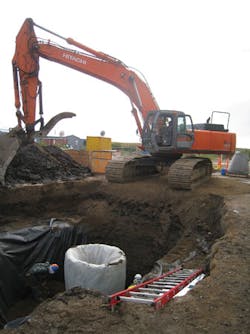WRDA For The WIIN
By Sarah Fister Gale
The U.S. political system may be more partisan than ever before, but that didn’t stop the Senate from finally reauthorizing the Water Resources Development Act (WRDA) in September with an almost unanimous bipartisan vote of 95-3.
WRDA has been around since 1974, as recurring legislation to authorize water infrastructure projects developed by the U.S. Army Corps of Engineers. The bill is meant to be reauthorized every two years; however, the approval process began to lag in the late ‘90s. Only two previous WRDA bills have been reauthorized in the last ten years (2007 and 2014), due in large part to conflict between parties, making the Senate passage of the 2016 bill that much more impressive.
“Getting that many senators to agree was a real achievement,” said Patricia Sinicropi, legislative director for the National Association of Clean Water Agencies (NACWA). She noted that the Senate WRDA bill is particularly comprehensive, including language to address affordability, integrated planning, and green infrastructure for stormwater management, all of which could benefit clean water utilities. “It represents a milestone legislative achievement for the clean water sector,” she said.
Claudio Ternieden, senior director of government affairs for the Water Environment Federation (WEF) agreed. “The water sector has done a lot to promote unity and messaging about the importance of increasing funding for water and wastewater infrastructure,” he said. And it is finally paying off.
Funds for Flint
The 2016 version of WRDA includes roughly $10 billion worth of navigation, flood control and environmental restoration projects eligible for Congress to fund. About $5 billion is targeted toward upkeep of ports, dams, locks and levies managed by the Corps.
It also provides for a five-year grant program to help communities offset costs associated with replacing lead service lines and interior plumbing components, and at least $170 million to address the water crisis in Flint, Mich. The Flint package would be used to support repairs to the city’s water treatment plant and transmission system, including damaged water pipes and service lines that caused high levels of lead to leech into the drinking water.
Tracey Mehan, deputy executive director for the American Water Works Association (AWWA) said he is excited to finally see the problems in Flint being addressed. “There has been a lot of discussion about Flint and lead this year, but not much legislative progress,” he said.
WIFIA gains support
The bill also authorizes $20 million to fund the Water Infrastructure Finance and Innovation Act (WIFIA), the five-year pilot program for the Environmental Protection Agency (EPA) to provide communities with low-interest federal loans and loan guarantees to partially finance major water and wastewater infrastructure. WIFIA is designed to complement the State Revolving Fund (SRF) programs that help fund smaller community initiatives.
The 2016 WRDA bill makes WIFIA a permanent part of the legislation (it was a temporary program in 2014) and allows recipients to finance the $100,000 loan application fee, which is good news for the program. It also explicitly makes drought prevention and mitigation projects eligible for funding.
In the meantime, $20 million for WIFIA was included in the final fiscal year (FY) 2016 omnibus bill, passed in mid-December at the eleventh hour to avoid a federal government shutdown. Signed by President Obama on Dec. 10, the continuing resolution, H.R. 2028, keeps the federal government in operation until April 28.
According to WEF, the continuing resolution funds the federal government at FY 2016 levels, minus a 0.19 percent across-the-board funding reduction to meet budget caps.
Although the omnibus bill has passed, WRDA is not yet a done deal. In December, it was rolled into a compromise bill, the Water Infrastructure Improvements for the Nation (WIIN) Act, S. 612.* The $10 billion authorization legislation also included the Water and Waste Act of 2016 and other measures, such as California drought relief and technical assistance for small and disadvantaged communities to meet federal water mandates. The WIIN Act passed Congress in mid-December and as we go to press, it awaits signature by President Obama.
“Passage of the WIIN Act demonstrates that investments in clean and safe water resources continue to be a top priority for Congress and is an issue that enjoys broad bi-partisan support,” said Adam Krantz, CEO of NACWA. “The investments that will be made as a result of this legislation will help communities across the country provide safe and clean water to its citizens. We look forward to building on this progress next Congress, and with the in-coming administration, as further investment in our water infrastructure will be worked on, and is still needed.”
“We applaud Congress on passing this major infrastructure bill. Once signed by the President, WIIN will provide funding for projects throughout the country, and much needed reforms to promote repair and replacement of our nation’s aging infrastructure,” said Jon R. Runge, CAE, president of the Ductile Iron Pipe Research Association (DIPRA). “We hope the passage of this bill sets the stage for a continued effort to address this nation’s water infrastructure.”
In the absence of a signed authorization bill, WEF’s biggest concern is where Congress will find funding to support WRDA. Since the money for the bill is not currently in place, it would have to be pulled from other programs. “We are hopeful the new administration will identify proper sources of funding for these projects that won’t reverse gains we’ve made in water quality improvement over the past decade,” said Ternieden.
Regardless of the final details, Sinicropi is confident that WRDA will push ahead, citing Speaker Paul Ryan’s public support for the bill and the fact that both parties are committed to infrastructure investments. “We believe they will fill funding gaps and inject new capital into these important projects,” she said.
Lead, Copper and PFOA/PFOS
While WRDA, WIFIA and SRFs were the leading legislative topics of 2016, there are a few other issues gaining momentum.
Many industry leaders are paying close attention to possible changes in the EPA’s Lead and Copper Rule (LCR). Mehan noted that while there is no clear timeline for publication of a proposed or final rule, EPA did recently release a paper describing regulatory options for revisions to the LCR.1 “The intent was to let people know how complex these issues are, and to address possible regulatory options to improve the existing rule,” he said.
EPA also released health advisories for perfluorooctanoic acid (PFOA) and perfluorooctanesulfonic acid (PFOS) in May 2016, with values that are substantially lower than the previously released provisional advisory levels - though no formal changes have yet been made. “We look forward to discussing these issues with EPA in the year ahead,” Mehan said.
Ternieden also pointed to EPA’s finalization of the Water E-Reporting Rule, which technically passed in late 2015, as a promising step for the water industry. Businesses with Clean Water Act permits to discharge wastewater must now file reports electronically instead of filing written paper reports to comply with the National Pollutant Discharge Elimination System (NPDES) program. “We think that was an important step, as it will translate into efficiencies and cost cutting,” Ternieden said. The EPA estimates that when the rule is fully implemented, participating states will save approximately $22.6 million each year as a result of switching from paper to electronic reporting.
In the meantime, most industry experts are waiting to see what impact the new administration will have on water infrastructure and ongoing regulations. “The election could have a big impact on financial dynamics, the growth of entitlements, and funding for WRDA and WIFIA,” Mehan said. But no one knows yet what they will be.
Regardless of what the new administration approves, the success of these bills will be tempered by whether legislators secure access to funds to stand them up, Mehan added. “No matter what happens, we have to keep advocating for water investments to the powers that be.”
*Editor’s Note: On December 16, 2016, President Obama signed the WIIN Act into law, stating that the legislation “authorizes vital water projects across the country to restore watersheds, improve waterways and flood control, and improve drinking water infrastructure.” You can read the bill in its entirety at www.congress.gov.
About the Author: Sarah Fister Gale is a Chicago-based correspondent for WaterWorld. Over the last 15 years, she has researched and written dozens of articles on water management trends, wastewater treatment systems and the impact of water scarcity on businesses and municipalities around the world.
Resources
1. “Lead and Copper Rule Revisions White Paper,” U.S. Environmental Protection Agency, Office of Water, October 2016.
WIIN Act Provisions
- Includes new public notice requirements for exceedances of the lead action level and for distribution of independently conducted lead tap samples results
- Includes a provision intended to limit competition between the new Water Infrastructure Finance and Innovation (WIFIA) program and the SRFs
- Provides new assistance ($60 million annually for 5 years) for small and disadvantaged communities to meet Clean Water Act and Safe Drinking Water Act mandates
- Provides new funding ($10 million annually for 5 years) to advance water infrastructure research and the use of innovative water technologies
- Provides critical resources ($60 million annually for 5 years) to replace lead drinking water infrastructure in communities and schools
- Provides critical funding ($100 million) for drinking water infrastructure emergencies identified by the President
- Includes a provision to allow tribal organizations’ interests to borrow the rural water EPA technical assistance provision that requires EPA to fund the technical assistance that the Indian tribes “find to be the most beneficial and effective.” This should be helpful for the return of rural water EPA technical assistance if the tribal organizations are successful in having funds appropriated specially for this new authorization.
Source: National Rural Water Association (NRWA)




